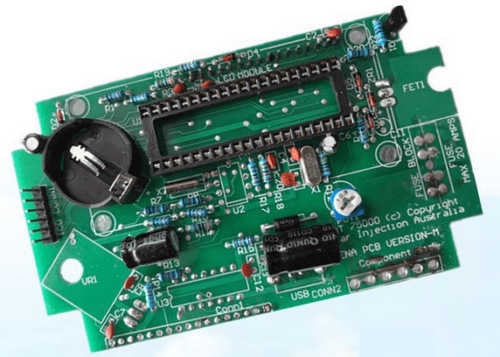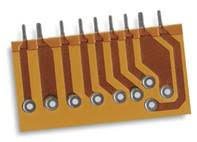What Is the Difference Between PCB and PCBA?
March 26, 2021PCB and PCBA are two very different concepts, but many people use the terms interchangeably. While these terms are related and both used regularly within the electronics industry, they have distinct definitions. In this article, we’ll discuss what PCBs and PCBAs are, how they are related, and the key differences between the two terms so you can use them both confidently when placing orders and describing products.
What Is PCB?
PCBs serve as a mechanical foundation in which various electrical components can be mounted to complete the intended circuit. PCBs feature a conductive pattern and a substrate that is typically made of epoxy resin material. Some of the most common types of printed circuit boards include:
- Single-layer
- Multi-layer
- Rigid
- Flexible
- Rigid-flex
With all of these different types available, manufacturers and product designers can create a diverse array of electronic displays, standalone devices, and more for consumer, commercial, and industrial applications.
What Is PCBA?
PCBA is the complete electronic assembly and relates to how the components are placed onto the PCB. More specifically, it refers to the process of passing the PCB through Surface Mounted Technology (SMT) and Plated Through Hole (PTH) processes to place and solder the various electrical components onto the PCB.
- During this assembly process, product builders mount the electronic components into holes running through either the whole board or just specific layers. The holes have conductive pads to ensure the flow of electricity is not interrupted.
- During this assembly process, the components are not mounted through holes. Instead, they are mounted onto the surface layer with pins along the conductive pads.
PCBAs are fitted will all necessary components and are ready to be used for their intended purpose.
Differences Between PCB and PCBA
As a simple way to keep the two terms straight, think of a PCB as the inert, unfinished foundation of a circuit and a PCBA as the complete product with active and passive components. PCBs are just the boards of substrate layers themselves that can support electronic components. The boards have conductive pads and tracks, etched features, and other details in the non-conductive layers, but they don’t yet have all the components. PCBAs are PCBs with solder paste and electronic components on the surface, and they are plug-in ready.
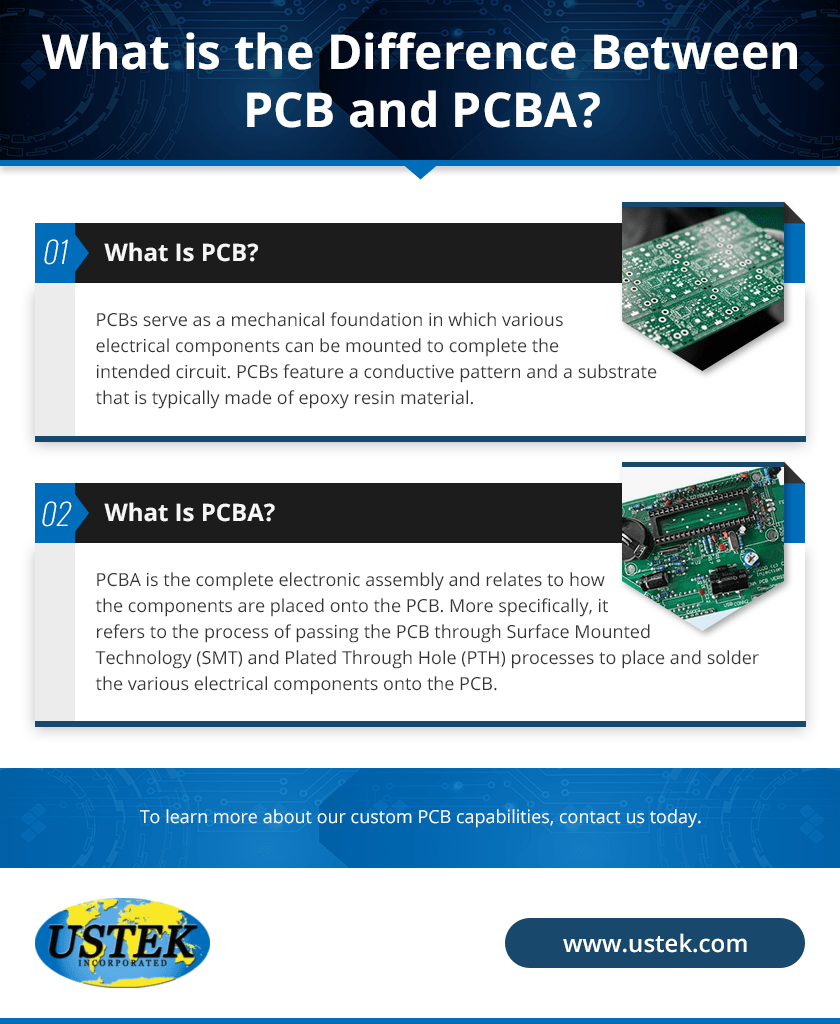
Printed Circuit Boards From USTEK
While PCBA refers to the finished, fully assembled board with all the electrical components it needs to perform, PCB only refers the bare circuit board that is used as the foundation for all of the electrical components. These terms are often used interchangeably, so understanding the differences between the two is crucial.
At USTEK Incorporated, we specialize in the design and construction from single-layer to multi-layer PCBs for a wide range of industries. We can work with you to create a custom solution for your needs no matter how complex. To learn more about our custom PCB capabilities, contact us today.
A Primer on the Types of Printed Circuit Boards
March 19, 2021Are you designing a new electronic device or upgrading an existing one? If so, chances are you’ll need printed circuit boards (PCBs). The self-contained boards mechanically support and electrically connect electrical and electronic components. The components are located on the surface of a non-conducting board (i.e., the substrate) and soldered to printed circuits (i.e., small layers of conductive material deposited on one or more sides of the substrate). When designed and manufactured properly, PCBs help ensure the device assembly in which they are installed operates and performs as intended.
PCBs come in many variations, each of which is suitable for different electronic applications. Below, we highlight and discuss the various types that are available.
Single-Sided PCBs
Single-sided PCBs have a single layer of substrate with components and circuitry on only one side. They are the easiest and cheapest type of PCB to design and manufacture. As such, they are commonly produced in high volumes. Typical applications include simpler circuits, such as relays, sensors, and electronic toys.
Double-Sided PCBs
Double-sided PCBs have components and circuitry on both sides of the substrate. Holes in the substrate allow for connections between circuits on different sides. Connections can be formed using one of two methods: through-hole or surface mount technology (SMT). The former involves feeding small wires (i.e., leads) through the holes and soldering the ends to the necessary components/circuit, while the latter involves soldering small leads directly to the substrate. Since the design and manufacture of these PCBs are more involved than single-sided ones, they are typically used for more complex circuits, such as amplifiers, mobile phones, power monitoring systems, and test equipment.
Multilayer PCBs
Multilayer PCBs have three or more conductive layers—one on top, one on bottom, and at least one sandwiched between non-conductive substrate layers. They allow for greater design flexibility in a smaller and lighter package. Due to their elevated cost compared to single-sided and double-sided PCBs, they are typically used for high-speed circuit applications rather than simpler and less critical circuit applications.
Flex PCBs
Flex PCBs can be single-sided, double-sided, or multilayer. In any case, they have flexible substrates, which allow them to fit into tight or compact spaces where rigid boards cannot. The material can turn and shift without damaging the printed circuits. They help reduce board size and weight, making them ideal for use in applications that need high signal trace density.
Rigid PCBs
Rigid PCBs are also available in single-sided, double-sided, or multilayer variations. They have rigid substrates that prevent the board assembly from twisting and turning. Their compact size ensures the integration of complex circuitry, while their well-organized signal paths and clearly marked components make them easy to maintain and repair.
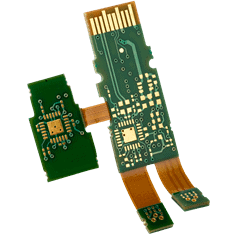 Rigid-Flex PCBs
Rigid-Flex PCBs
Rigid-flex PCBs combine the qualities of rigid PCBs and flex PCBs. They consist of flexible circuits attached to rigid boards. By accommodating streamlined designs, they help reduce overall board weight and size. As a result, they are commonly used in automobiles, cellphones, digital cameras, pacemakers, and other electronic devices and systems with tight weight and size limitations.
High-Frequency PCBs
High-frequency PCBs are designed for use in frequency ranges of 500MHz to 2GHz. Typical applications include communication systems, microwaves, and microstrips. Depending on the application, they may require advanced laminate materials and controlled impedance capabilities.
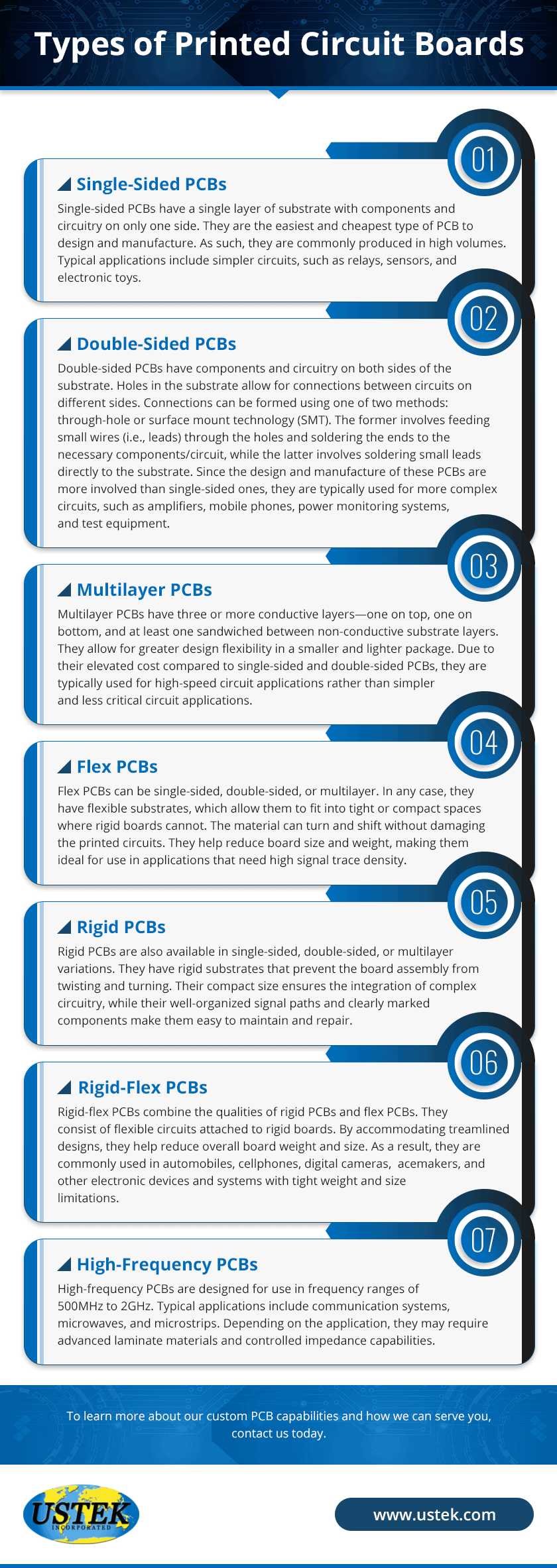
Contact USTEK for Your PCB Needs Today!
For PCBs you can trust, turn to the experts at USTEK! As a premier custom manufacturer of electrical and metal components with experience designing and constructing PCBs for various industries, we can work with you to develop a custom PCB solution that fully meets your needs. Whether you require basic, single-sided PCBs for simple circuits or complex, multilayer PCBs with high-frequency capabilities, we’ve got you covered. To learn more about our custom PCB capabilities and how we can serve you, contact us today.


